Citroen C4 DAG 2014.5 2.G Owner's Manual
Manufacturer: CITROEN, Model Year: 2014.5, Model line: C4 DAG, Model: Citroen C4 DAG 2014.5 2.GPages: 340, PDF Size: 12.89 MB
Page 211 of 340

1111
209
C4-2_en_Chap11_info-pratique_ed01-2014
Dashboard fuses
The fuseboxes are located in the lower dashboard
(left-hand side).
Access to the fuses
F
Refer
to
the
paragraph
"Access
to
the
tools". Fuse tables
Fusebox 1
Fuse N° Rating Functions
F8 3 AAlarm
siren, alarm ECU.
F13 10 A12
V socket.
F14 10 A12
V socket in boot.
F16 3 ALighting
for the large multifunctional storage unit,
rear
map reading lamps, glove box illumination.
F17 3 ASun
visor illumination, front map reading lamps.
F28 15 AAudio
system, radio (after-market).
F30 20 ARear
wiper.
F32 10 AHi-Fi
amplifier.
PRACTICAL INFORMATION
Page 212 of 340

1111
210
C4-2_en_Chap11_info-pratique_ed01-2014
Fuse N° RatingFunctions
F36 15 ARear
12 V socket.
F37 - Not
used.
F38 - Not
used.
F39 - Not
used.
F40 25 A230
V / 50 Hz socket.
Fusebox 2
PRACTICAL INFORMATION
Page 213 of 340

1111
211
C4-2_en_Chap11_info-pratique_ed01-2014
Fuse N° RatingFunctions
F19 30 AWindscreen
wipers slow / fast speed.
F20 15 AFront
and rear screenwash pump.
F21 20 AHeadlamp
wash pump.
F22 15 AHorn.
F23 15 ARight-hand
main beam headlamp.
F24 15 ALeft-hand
main beam headlamp.
F27 5 ALeft-hand
dipped headlamp.
F28 5 ARight-hand
dipped headlamp.
Engine compartment fuses
The fusebox is placed in the engine compartment
near the battery (left-
hand
side).
Access to the fuses
F
Unclip
the cover.
F
Change
the
fuse
(see
correspond
-
ing
paragraph).
F
When
you
have
finished,
close
the
cover
carefully
to
ensure
sealing
of
the
fusebox. Fuse table
PRACTICAL INFORMATION
Page 214 of 340
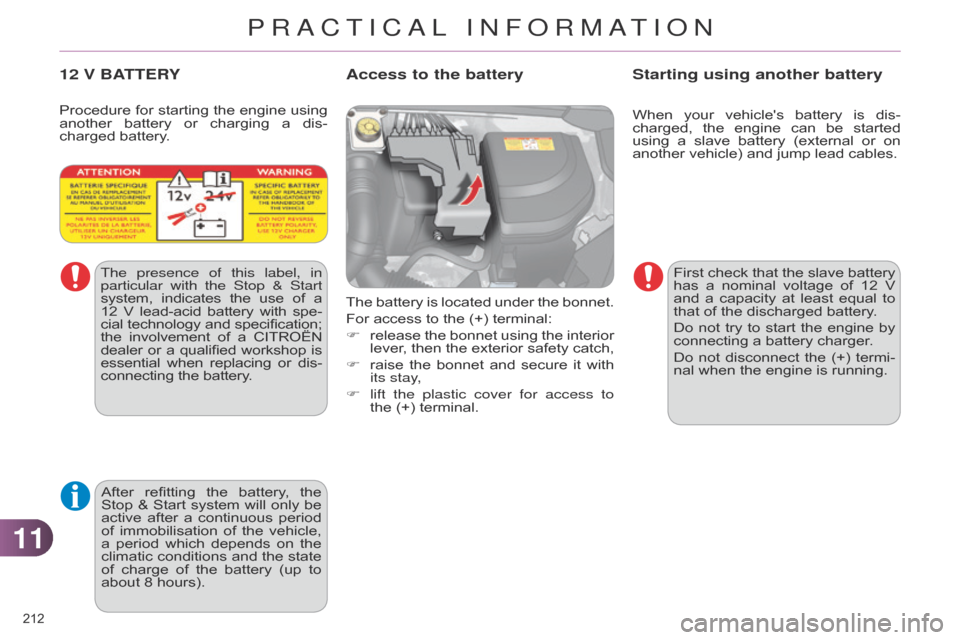
1111
212
C4-2_en_Chap11_info-pratique_ed01-2014
When your vehicle's battery is dis -
charged, the engine can be started
using
a
slave
battery
(external
or
on
another
vehicle) and jump lead cables.
Starting using another battery
12 V
BATTERY
The battery is located under the bonnet.
For access to the (+) terminal:
F
release
the
bonnet
using
the
interior
lever
,
then
the
exterior
safety
catch,
F
raise
the
bonnet
and
secure
it
with
its stay
,
F
lift the plastic cover for access to
the (+)
terminal.
Access to the battery
The presence of this label, in
particular with the Stop & Start
system,
indicates
the
use
of
a 12
V
lead-acid
battery
with
spe
-
cial
technology
and
specification; the
involvement
of
a
CITROËN dealer
or
a
qualified
workshop
is essential
when
replacing
or
dis
-
connecting
the battery.
Procedure
for
starting
the
engine
using
another
battery
or
charging
a
dis
-
charged battery.
After
refitting
the
battery
,
the
Stop
&
Start
system
will
only
be
active
after
a
continuous
period
of
immobilisation
of
the
vehicle,
a
period
which
depends
on
the
climatic
conditions
and
the
state
of
charge
of
the
battery
(up
to
about
8 hours). First
check that the slave battery has
a nominal voltage of 12 V
and
a
capacity
at
least
equal
to
that
of the discharged battery.
Do
not
try
to
start
the
engine
by
connecting
a battery charger.
Do
not
disconnect
the
(+)
termi
-
nal
when the engine is running.
PRACTICAL INFORMATION
Page 215 of 340
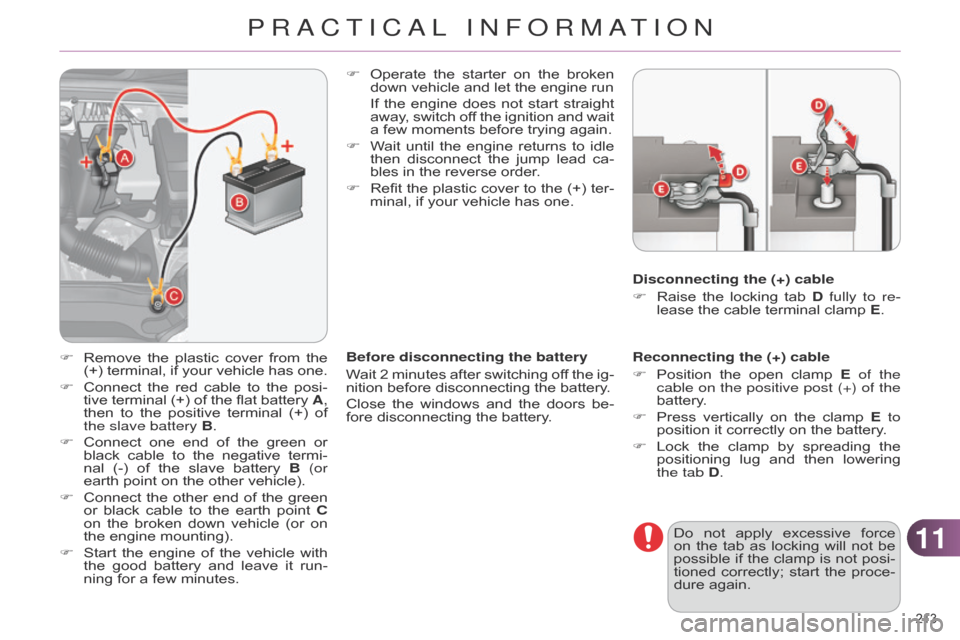
1111
213
C4-2_en_Chap11_info-pratique_ed01-2014
Reconnecting the (+) cable
F
Position
the
open
clamp
E
of the
cable on the positive post (+) of the
battery.
F
Press
vertically
on
the
clamp
E
to
position
it correctly on the battery.
F
Lock
the
clamp
by
spreading
the
positioning
lug
and
then
lowering
the tab
D.
F
Operate
the
starter
on
the
broken
down
vehicle
and
let
the
engine
run
If
the
engine
does
not
start
straight
away
,
switch
of
f
the
ignition
and
wait
a
few
moments
before
trying
again.
F
W
ait
until
the
engine
returns
to
idle
then
disconnect
the
jump
lead
ca
-
bles
in
the
reverse
order.
F
Refit
the
plastic
cover
to
the
(+)
ter
-
minal,
if
your
vehicle
has
one.
Before disconnecting the battery
Wait
2
minutes
after
switching
of
f
the
ig
-
nition
before
disconnecting
the
battery.
Close
the
windows
and
the
doors
be
-
fore
disconnecting
the
battery. Disconnecting the (+) cable
F
Raise
the
locking
tab
D
fully to re-
lease the cable terminal clamp E.
Do
not
apply
excessive
force
on
the
tab
as
locking
will
not
be
possible
if
the
clamp
is
not
posi
-
tioned
correctly;
start
the
proce
-
dure
again.
F
Remove
the
plastic
cover
from
the
(+)
terminal,
if
your
vehicle
has
one.
F
Connect
the
red
cable
to
the
posi
-
tive
terminal
(+)
of
the
flat
battery
A
,
then
to
the
positive
terminal
(+)
of
the slave battery
B.
F
Connect
one
end
of
the
green
or
black
cable
to
the
negative
termi
-
nal (-)
of
the
slave
battery
B
(or
earth
point
on
the
other
vehicle).
F
Connect
the
other
end
of
the
green
or
black
cable
to
the
earth
point
C
on
the
broken
down
vehicle
(or
on
the
engine
mounting).
F
Start
the
engine
of
the
vehicle
with
the
good
battery
and
leave
it
run
-
ning
for
a
few
minutes.
PRACTICAL INFORMATION
Page 216 of 340
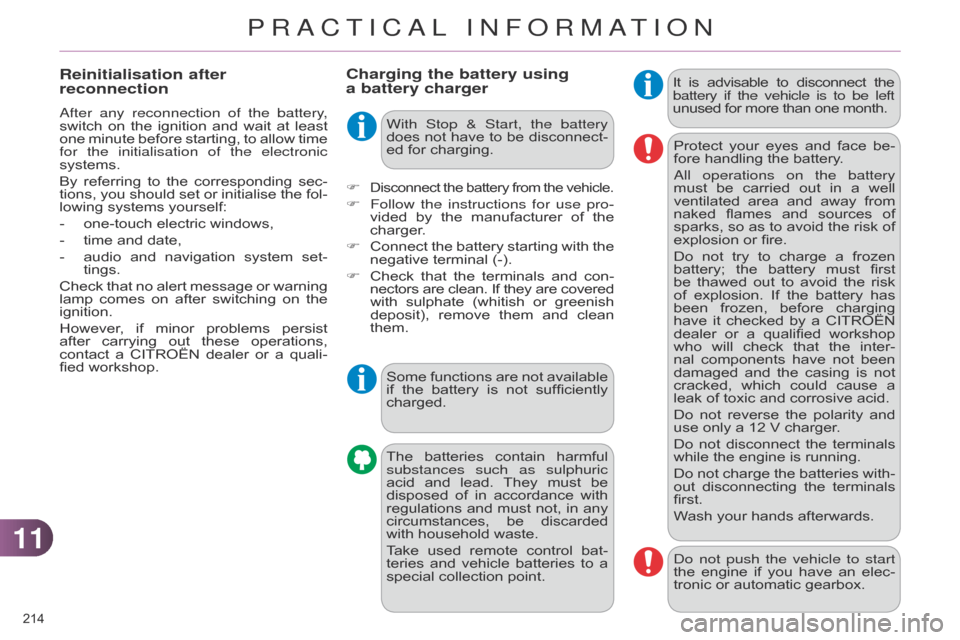
1111
214
C4-2_en_Chap11_info-pratique_ed01-2014
Charging the battery using
a battery chargerIt is advisable to disconnect the battery if the vehicle is to be left
unused
for more than one month.
The
batteries
contain
harmful
substances
such as sulphuric
acid
and
lead.
They
must
be
disposed
of
in
accordance
with
regulations
and
must
not,
in
any
circumstances,
be
discarded
with
household
waste.
Take
used
remote
control
bat
-
teries
and
vehicle
batteries
to
a
special
collection
point.
F
Disconnect the battery from the vehicle.
F Follow the instructions for use pro -
vided by the manufacturer of the
charger
.
F
Connect
the
battery
starting
with
the
negative
terminal (-).
F
Check
that
the
terminals
and
con
-
nectors
are
clean.
If
they
are
covered with
sulphate
(whitish
or
greenish
deposit),
remove
them
and
clean
them. Protect
your
eyes
and
face
be
-
fore handling the battery.
a
ll operations on the battery
must be carried out in a well ventilated
area and away from naked
flames and sources of
sparks,
so
as
to
avoid
the
risk
of
explosion
or fire.
Do
not
try
to
charge
a
frozen
battery;
the
battery
must
first
be
thawed
out
to
avoid
the
risk
of
explosion.
If
the
battery
has
been
frozen,
before
charging
have
it
checked
by
a
CITROËN
dealer
or
a
qualified
workshop
who
will
check
that
the
inter
-
nal
components
have
not
been
damaged
and
the
casing
is
not
cracked,
which
could
cause
a
leak
of toxic and corrosive acid.
Do
not
reverse
the
polarity
and
use
only a 12 V charger.
Do
not
disconnect
the
terminals
while
the engine is running.
Do
not
charge
the
batteries
with
-
out
disconnecting
the
terminals
first.
W
ash your hands afterwards.
Reinitialisation after
reconnection
after any reconnection of the battery,
switch on the ignition and wait at least
one
minute
before
starting,
to
allow
time
for
the initialisation of the
electronic
systems.
By
referring
to
the
corresponding
sec
-
tions,
you
should
set
or
initialise
the
fol
-
lowing
systems yourself:
-
one-touch
electric windows,
-
time
and date,
-
audio
and
navigation
system
set
-
tings.
Check
that
no
alert
message
or
warning
lamp
comes
on
after
switching
on
the
ignition.
However
,
if
minor
problems
persist
after
carrying
out
these
operations,
contact
a
CITROËN
dealer
or
a
quali
-
fied
workshop. Some
functions
are
not
available
if
the
battery
is
not
sufficiently
charged.
d
o not push the vehicle to start
the
engine
if
you
have
an
elec
-
tronic
or automatic gearbox.
With Stop & Start, the battery
does
not
have
to
be
disconnect
-
ed
for charging.
PRACTICAL INFORMATION
Page 217 of 340
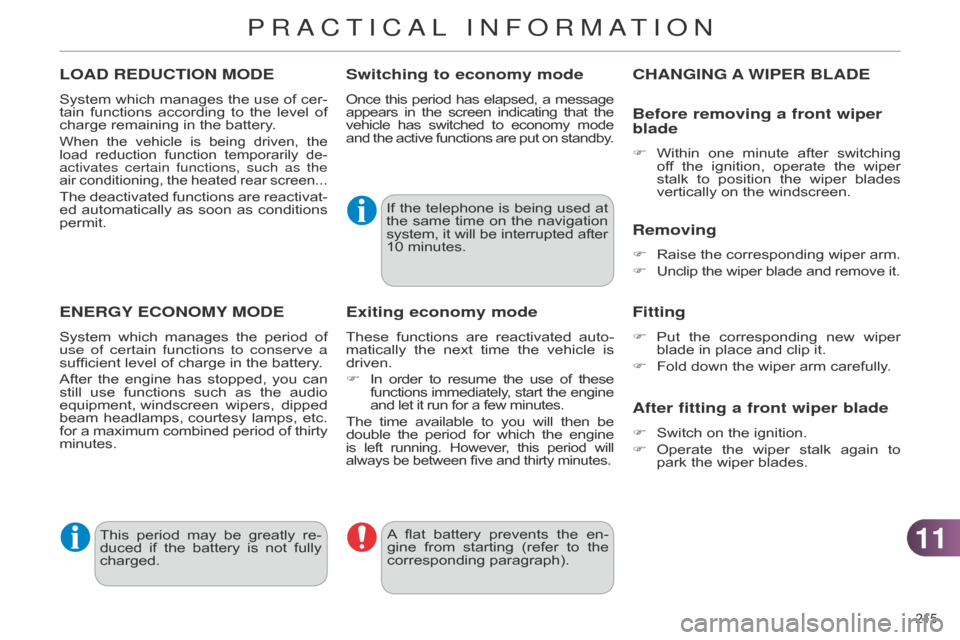
1111
215
C4-2_en_Chap11_info-pratique_ed01-2014
LOAD REDUCTION MODE
System which manages the use of cer -
tain functions according to the level of
charge
remaining in the battery.
When the vehicle is being driven, the load
reduction function temporarily de -
activates certain functions, such as the
air
conditioning,
the
heated
rear
screen...
The deactivated functions are reactivat -
ed automatically as soon as conditions
permit.
ENERGY ECONOMY MODE
System which manages the period of use of certain functions to conserve a
sufficient
level of charge in the battery.
After
the
engine
has
stopped,
you
can
still
use
functions
such
as
the
audio
equipment,
windscreen
wipers,
dipped
beam
headlamps,
courtesy
lamps,
etc.
for
a
maximum
combined
period
of
thirty minutes.
Switching to economy mode
Once this period has elapsed, a message appears
in the screen indicating that the vehicle
has
switched
to
economy
mode and
the
active
functions
are
put
on
standby
.
If the telephone is being used at the
same time on the navigation
system,
it
will
be
interrupted
after 10
minutes.
A
flat
battery
prevents
the
en
-
gine
from
starting
(refer
to
the
corresponding
paragraph).
Exiting economy mode
These functions are reactivated auto -
matically the next time the vehicle is
driven.
F
In
order
to
resume
the
use
of
these functions
immediately
,
start
the
engine and
let it run for a few minutes.
The
time
available
to
you
will
then
be double
the
period
for
which
the
engine is left running. However , this period will
always be between five and thirty minutes.
This period may be greatly re -
duced if the battery is not fully
charged.
CHANGING A WIPER BLADE
Before removing a front wiper
blade
F Within one minute after switching of
f the ignition, operate the wiper
stalk
to
position
the
wiper
blades
vertically
on the windscreen.
Removing
F Raise the corresponding wiper arm.
F
Unclip
the wiper blade and remove it.
Fitting
F Put the corresponding new wiper blade
in place and clip it.
F
Fold
down the wiper arm carefully.
After fitting a front wiper blade
F Switch on the ignition.
F
Operate
the
wiper
stalk
again
to
park
the wiper blades.
PRACTICAL INFORMATION
Page 218 of 340
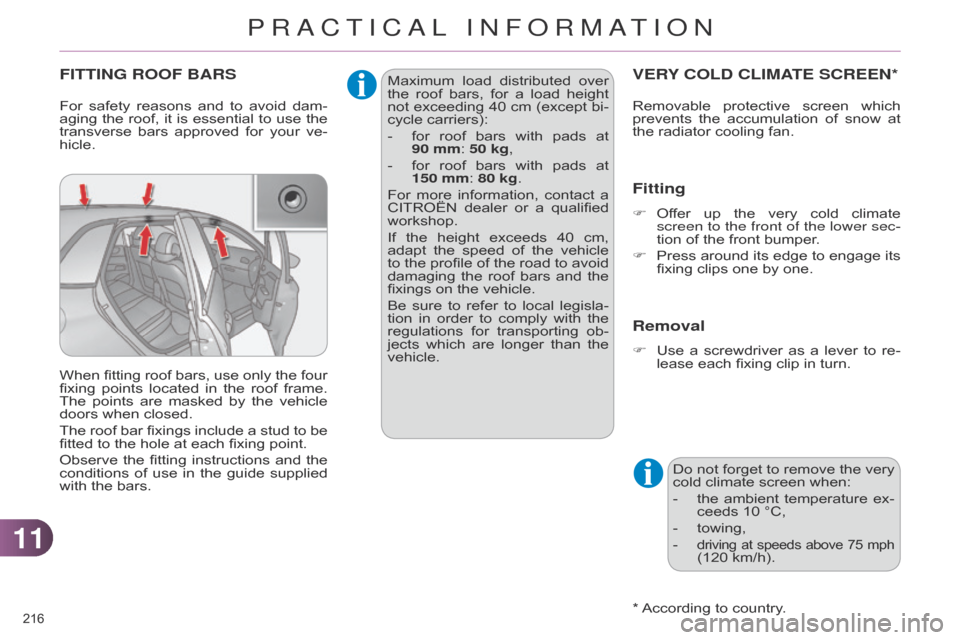
1111
216
C4-2_en_Chap11_info-pratique_ed01-2014
VERY COLD CLIMATE SCREEN *
* According to country.
Fitting
F Offer up the very cold climate screen to the front of the lower sec
-
tion
of the front bumper.
F
Press
around
its
edge
to
engage
its
fixing
clips one by one.
Removal
F Use a screwdriver as a lever to re -
lease each fixing clip in turn.
Do
not
forget
to
remove
the
very
cold
climate screen when:
-
the
ambient
temperature
ex
-
ceeds
10 °C,
-
towing,
-
driving at speeds above 75 mph
(120
km/h).
Removable
protective
screen
which
prevents
the
accumulation
of
snow
at
the
radiator
cooling
fan.
FITTING ROOF BARS
For safety
reasons and to avoid dam -
aging the roof, it is essential to use the
transverse
bars
approved
for
your
ve
-
hicle.
When
fitting
roof
bars,
use
only
the
four
fixing
points
located
in
the
roof
frame.
The
points
are
masked
by
the
vehicle
doors
when closed.
The
roof
bar
fixings
include
a
stud
to
be
fitted
to the hole at each fixing point.
Observe
the
fitting
instructions
and
the
conditions
of
use
in
the
guide
supplied
with
the bars. Maximum
load
distributed
over
the
roof bars, for a load height not
exceeding 40 cm (except bi -
cycle
carriers):
-
for
roof
bars
with
pads
at
90
mm: 50 kg,
-
for
roof
bars
with
pads
at
150
mm: 80 kg.
For
more
information,
contact
a
CITROËN
dealer
or
a
qualified
workshop.
If
the
height
exceeds
40
cm,
adapt
the
speed
of
the
vehicle
to
the
profile
of
the
road
to
avoid
damaging
the
roof
bars
and
the
fixings
on the vehicle.
Be
sure
to
refer
to
local
legisla
-
tion
in
order
to
comply
with
the
regulations
for
transporting
ob
-
jects
which
are
longer
than
the
vehicle.
PRACTICAL INFORMATION
Page 219 of 340
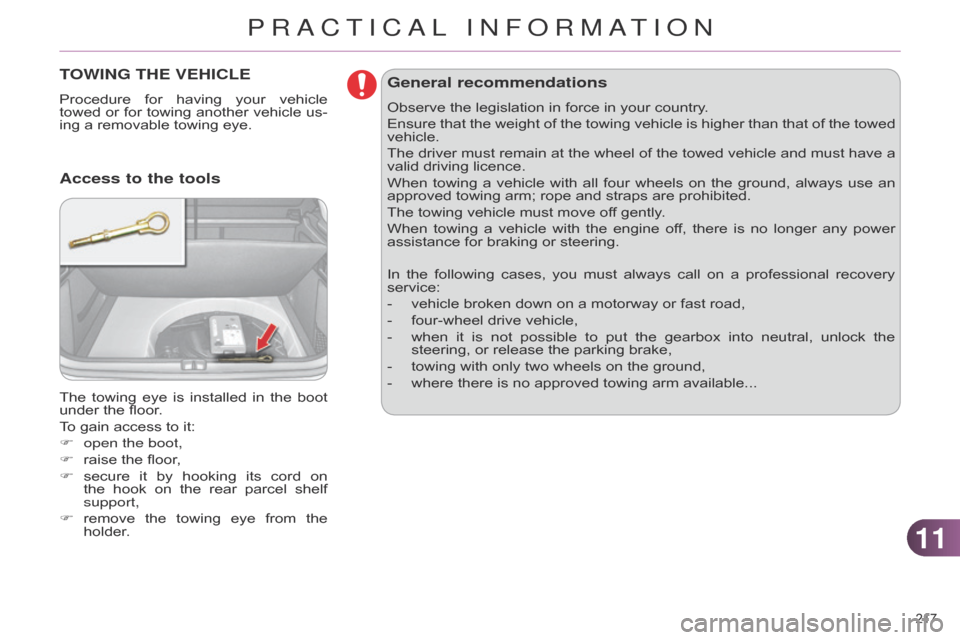
1111
217
C4-2_en_Chap11_info-pratique_ed01-2014
TOWING THE VEHICLE
Procedure for having your vehicle towed
or for towing another vehicle us -
ing
a removable towing eye.
The
towing
eye
is
installed
in
the
boot
under
the floor.
To
gain access to it:
F
open the boot,
F
raise
the floor,
F
secure
it
by
hooking
its
cord
on
the
hook
on
the
rear
parcel
shelf
support,
F
remove
the
towing
eye
from
the
holder
.
Access to the tools General recommendations
Observe the legislation in force in your country.
Ensure
that
the
weight
of
the
towing
vehicle
is
higher
than
that
of
the
towed
vehicle.
The
driver
must
remain
at
the
wheel
of
the
towed
vehicle
and
must
have
a
valid
driving licence.
When
towing
a
vehicle
with
all
four
wheels
on
the
ground,
always
use
an
approved
towing arm; rope and straps are prohibited.
The
towing vehicle must move off gently.
When
towing
a
vehicle
with
the
engine
of
f,
there
is
no
longer
any
power
assistance
for braking or steering.
In
the
following
cases,
you
must
always
call
on
a
professional
recovery
service:
-
vehicle
broken down on a motorway or fast road,
-
four-wheel
drive vehicle,
-
when
it
is
not
possible
to
put
the
gearbox
into
neutral,
unlock
the
steering,
or release the parking brake,
-
towing
with only two wheels on the ground,
-
where
there is no approved towing arm available...
PRACTICAL INFORMATION
Page 220 of 340
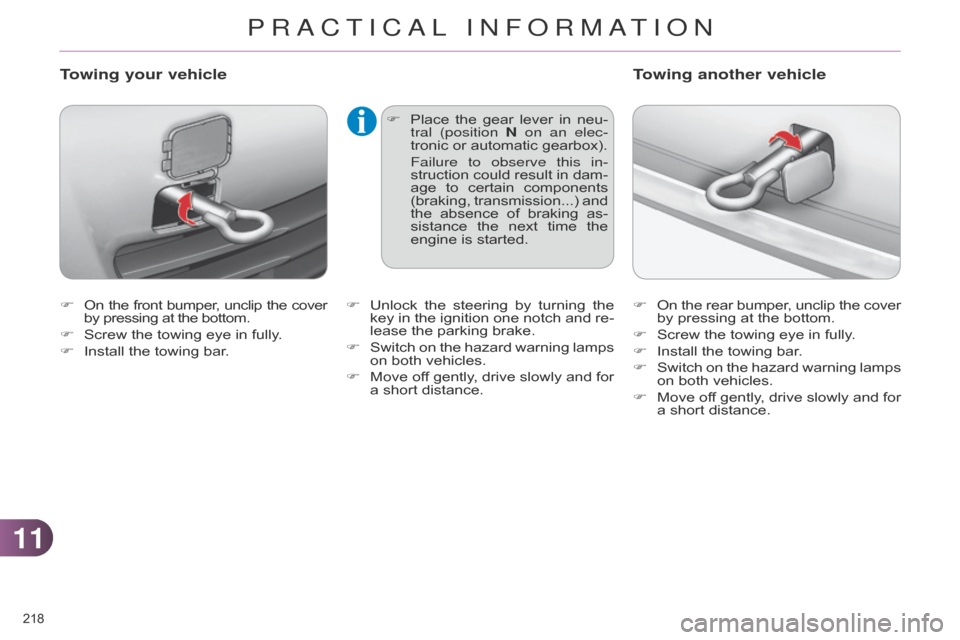
1111
218
C4-2_en_Chap11_info-pratique_ed01-2014
F On the front bumper , unclip the cover by
pressing at the bottom.
F
Screw
the towing eye in fully.
F
Install
the towing bar.
Towing your vehicle
F Place the gear lever in neu -
tral (position N on an elec-
tronic
or automatic gearbox).
Failure to observe this in
-
struction
could
result
in
dam
-
age
to
certain
components
(braking,
transmission...)
and
the
absence
of
braking
as
-
sistance
the
next
time
the
engine
is started. F
On
the
rear
bumper
,
unclip
the
cover by
pressing at the bottom.
F
Screw
the towing eye in fully.
F
Install
the towing bar.
F
Switch
on
the
hazard
warning
lamps
on
both vehicles.
F
Move
of
f
gently
,
drive
slowly
and
for
a
short distance.
Towing another vehicle
F Unlock the steering by turning the key
in the ignition one notch and re -
lease
the parking brake.
F
Switch
on
the
hazard
warning
lamps
on
both vehicles.
F
Move
of
f
gently
,
drive
slowly
and
for
a
short distance.
PRACTICAL INFORMATION